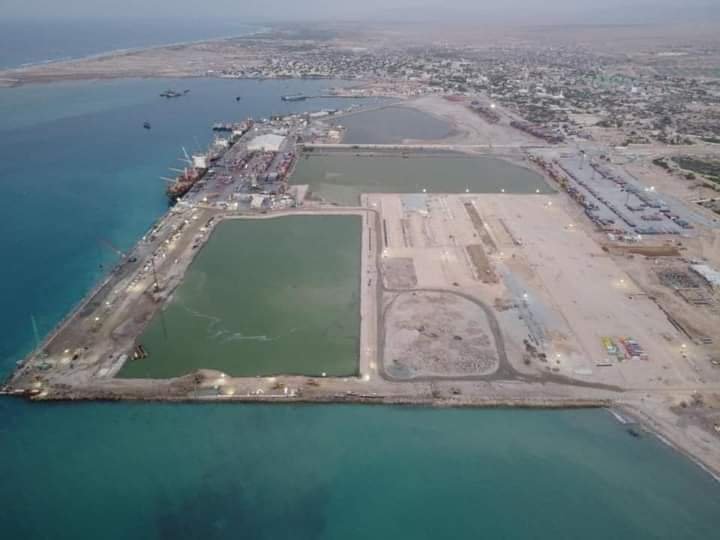-
Content Count
137 -
Joined
-
Last visited
-
Days Won
4
Posts posted by YaxaaS
-
-
 No Foothold for al-Shabaab in Somaliland - Jamestown
JAMESTOWN.ORG
No Foothold for al-Shabaab in Somaliland - Jamestown
JAMESTOWN.ORG
The tempo of al-Shabaab’s operations in Somalia has steadily increased, despite a dramatic escalation in U.S.-led drone strikes in Somalia. In July alone, al-Shabaab targeted the head of Somalia’s...The tempo of al-Shabaab’s operations in Somalia has steadily increased, despite a dramatic escalation in U.S.-led drone strikes in Somalia. In July alone, al-Shabaab targeted the head of Somalia’s military and launched attacks on five different targets in a single day (al-Jazeera, July 13). The targets included a well-fortified base defended by Ethiopian soldiers and a military encampment manned by Kenyan forces (Garowe Online, July 19).
Rather than becoming weaker and less capable as a result of increased pressure from the United States and the African Union Mission in Somalia (AMISOM), al-Shabaab’s ability to plan and carry out complex operations against hardened targets remains intact. In fact, indications have emerged that al-Shabaab is gaining new capabilities and tactics, such as the use of hand-launched drones.
Al-Shabaab has failed to establish an enduring presence in the autonomous but unrecognized Republic of Somaliland. In contrast, al-Shabaab and the Islamic State enjoy considerable operational freedom in the neighboring Somali state of Puntland.
The government of Somaliland’s military budget is the equivalent of an accounting error when compared with what has been—and continues to be—spent in Somalia by its international backers. Somaliland does not rely on foreign forces and the United States is not allowed—and there is not any need—to carry out drone attacks in the unrecognized republic. Yet, with its limited resources, Somaliland has achieved what the military forces of Kenya, Turkey, Ethiopia, and the United States have failed to achieve in Somalia: it has denied al-Shabaab a foothold.
How has Somaliland achieved this? First, Somaliland has a government that is relatively responsive to its citizen’s needs and demands. Consequently, even though there are growing political divisions, most Somalilanders support and trust their elected representatives and the presidency. Second, and more directly, human intelligence (HUMINT) forms the bedrock of Somaliland’s counter-terrorism strategy. Accurate and timely human intelligence that allows for quick responses to threats stemming from close informal and formal ties between Somaliland’s military and intelligence service and those communities most vulnerable to al-Shabaab.
Localized support for—and participation in—counter-terror efforts are critical components of Somaliland’s battle against al-Shabaab. Without this, al-Shabaab operatives infiltrate vulnerable towns and villages and, more often than not, establish an enduring presence.
Al-Shabaab’s ability to insert itself into communities is clear in parts of Somalia and Puntland, where it often provides greater predictability and more security than the Somali government. Despite harsh tactics and an ideology that alienates most Somalis, al-Shabaab enjoys genuine support. Al-Shabaab also uses its capable intelligence and security apparatus, the Amniyat, to cow and kill those who oppose it. Like all successful and durable insurgent and terrorist groups, al-Shabaab understands that abiding ties to local elites and the HUMINT that they provide are essential. Granular, timely, and accurate HUMINT is the ultimate force multiplier. It costs little or nothing and is not dependent on vulnerable and expensive war making technologies.
Those in charge of Somaliland’s military and intelligence service also understand the importance of human intelligence. It is this understanding that informs most of their counter-terror efforts and it is what allows their small and chronically underfunded military and police forces to successfully take on al-Shabaab.
Somaliland’s National Intelligence Service (NIS) and the army and police’s own intelligence officers prioritize community-led efforts to monitor and assess potential encroachments by al-Shabaab. Intelligence collection relies on both formal and informal networks for information. These networks encompass clan elders, local police, merchants, and even qat traders.
Information about new arrivals to towns and villages or any activity that does not fit accepted patterns is relayed up the chain of command to authorities in regional capitals or the national capital of Hargeisa. Responses by the police and military to threats are usually precise, timely, and most critically tailored to the specific socio-political dynamics of the area at risk.
This kind of response was demonstrated in late 2019 when al-Shabaab operatives entered the region of Sanaag in eastern Somaliland. Sanaag shares a border with Puntland and, as one of Somaliland’s least developed regions, is especially susceptible to infiltration by al-Shabaab. The region’s topography, which includes rugged, well-watered, mountains, and a lengthy coastline make it attractive to al-Shabaab.
During November of 2019, al-Shabaab dispatched fighters across the border with Puntland and briefly occupied two towns nestled in the Garof Hills (Horseed Media, November 17, 2019). Within hours of the incursion, officials within the NIS and the Somaliland Army initiated a response that marshaled local militias and select police and army units. Police and army units coordinated their efforts with those of local militias, who had first raised the alarm about the incursion, to evict al-Shabaab’s operatives. [1] To date, al-Shabaab has not returned to this area—at least not overtly. Al-Shabaab’s Amniyat maintains its own network of informants in Somaliland.
The armed forces of Somaliland do not possess aircraft, and even transport vehicles are in short supply. The government struggles to rapidly deploy soldiers and police to where they are required, especially in areas with rough terrain and few roads. First rate HUMINT and the close relationships with community leaders is the government’s primary way of compensating for these deficiencies. Some within Somaliland’s government have even proposed reviving mounted patrols as a way of increasing force mobility and keeping costs down. [2] To compensate for limited budgets, a lack of transport, and limited manpower, the government of Somaliland must rely on the relationships it builds at the local level. While this approach is partly driven by constraints on resources, it is one of the primary reasons why al-Shabaab has yet to establish a foothold in Somaliland.
The HUMINT that Somaliland relies on and the good relations that its military and intelligence services have with communities throughout much the country are co-constructive: one does not exist without the other. As al-Shabaab launches ever more brazen attacks on the well-equipped military forces of Kenya, Ethiopia, and even the United States, much can be learned from Somaliland’s counter-terrorism efforts (al-Jazeera, January 6). Ironically, Somaliland’s limited resources force it to make better decisions than neighboring Somalia.
-
 1
1
-
 1
1
-
-
We aint heard much about Shidan and Waqdariya of late any new developments?
-
Fundraising for a natural disaster is a worthy cause, but when you politisize it you lose credibility.
-
 1
1
-
-
-
16 minutes ago, Timacaddeh said:Are you Sweden based, Mr Yaxaas?
No bro, just know a few Swedish Geezers

-
-
Strictly Swedish
 good cinematography non the less.
good cinematography non the less.
 DNA-teknik ska avslöja hemligheter i människans ursprungshem | SVT Nyheter
WWW.SVT.SE
DNA-teknik ska avslöja hemligheter i människans ursprungshem | SVT Nyheter
WWW.SVT.SE
För första gången används ny dna-teknik för att spåra människans historia i Somaliland i östra Afrika. – Här finns fantastiskt material att undersöka, säger Anders Götherström, professor i molekylär arkeologi...-
 1
1
-
-
-
-
-
Hope prison personnel get paid!
-
 Weather and war: How climate shocks are compounding Somalia’s problems
WWW.THENEWHUMANITARIAN.ORG
Weather and war: How climate shocks are compounding Somalia’s problems
WWW.THENEWHUMANITARIAN.ORG
Somalia is on the front line of climate change. But with the weak state under constant attack from al-Shabab, action is way short of needs.Money going on other things
In the aftermath of the 2016-2017 drought, the new federal government of President Mohamed Abdullahi Mohamed (Farmajo) – with the support of the EU, the UN, and the World Bank – put together a recovery and resilience framework to guide future policy.
The principle finding of the “Somalia Drought Impact and Needs Assessment” was that Somalia is undergoing a climate emergency in which droughts, floods, and desertification are wreaking havoc on the country’s livestock and farming sectors, which have sustained people for centuries.
Water, whether too little or too much, is at the heart of this crisis – and the UN has warned that the situation will worsen.
The report recommended urgent water management initiatives to improve Somalia’s irrigation facilities. These included: better use of floodwater; and the rehabilitation and construction of water harvesting systems – typically used to capture and store rainwater.
But since the publication of the report in April 2018, very few of those recommendations have been implemented.
One big stumbling block is the lack of money. Somalia is one of the world’s poorest countries, with capital spending accounting for just three percent of total expenditure, according to the World Bank.
The United States, the biggest bilateral donor, spends virtually all of its aid money on the emergency response and on the conflict, peace, and security sectors.
Ongoing insurgency
But that runs into a second major problem – the insecurity in the countryside as a result of al-Shabab, for whom rural development projects would be tempting targets.
Al-Shabab remains a “formidable fighting force” despite years of operations against it by the African Union’s military intervention, known as AMISOM, and Western special forces, according to a June report by the International Crisis Group.
“Today, you secure an area, but you’re not very sure that tomorrow it will be secure.”
“The problem is the level of unpredictability,” AMISOM spokesman Charles Imbiakha told TNH. “Today, you secure an area, but you’re not very sure that tomorrow it will be secure. And that’s why those periodic attacks are still happening in Somalia.”
Climate change in Somalia is increasingly a national security issue, according to a report released last month by the Stockholm International Peace Research Institute.
Displacement as a result of drought, and growing tensions between herders, farmers, and clans allow al-Shabab to exploit the “grievances of the population that stem from weather-related losses”, the report noted. As a result, “insurgent groups gain recruitment opportunities and [their] political narratives gain support”, it added.
-
 Somali Floods Displace Hundreds of Thousands, Raise Fears of Coronavirus Spread
WWW.VOANEWS.COM
Somali Floods Displace Hundreds of Thousands, Raise Fears of Coronavirus Spread
WWW.VOANEWS.COM
Surging floodwaters in the southern regions of Somalia have driven more than 650,000 people to flee their homes this year. The U.N. refugee agency reports the flooding has caused food shortages, led to...Africa
Somali Floods Displace Hundreds of Thousands, Raise Fears of Coronavirus Spread
August 07, 2020 02:35 PM
GENEVA - Surging floodwaters in the southern regions of Somalia have driven more than 650,000 people to flee their homes this year. The U.N. refugee agency reports the flooding has caused food shortages, led to the outbreak of killer diseases and increased the risk of the coronavirus spreading in the country.
More than 150,000 flood victims have become homeless since late June, including 23,000 in the past week, according to officials. Weather forecasters warn the worst is not over. They predict the heavy rains and extreme flooding will continue for some time in certain regions and exacerbate the living conditions of the hundreds of thousands of displaced.
U.N. refugee agency spokesman Charlie Yaxley reports many of the newly displaced are living in overcrowded, makeshift shelters with little protection from the harsh weather. He says families are exposed to increased risk of crimes such as robbery and rape.
Food is in short supply and many are going hungry with rising malnutrition in children, leaving them at risk of starvation," he said. "Sanitary conditions are poor and access to medical care is scarce and health partners warn of a risk of diarrhea, vector-borne diseases, respiratory-tract infections and other communicable diseases rapidly spreading amongst the displaced population."
Yaxley says there has been no reported major coronavirus outbreak, but he tells VOA the outlook is not good. He says people have little access to clean water, the cramped quarters prevent social distancing, and very little sanitation infrastructure is in place.
"So conditions are ripe for transmission of viruses, including COVID-19, and it is exacerbated even further because in some areas, we are not able to access some of the affected communities. And some areas, particularly in the southern part, are controlled by armed groups and militias."
-
-
-
-
Oodweyne
They can't keep up. Befuddled, bemused and bewildered by Somaliland’s growing gravitas at international diplomacy. While they play tiddlywinks with Mudulood this and Dhuusomareeb 2.4 that. At least they're a curious bunch.
-
 1
1
-
 3
3
-
-
9 minutes ago, Timacaddeh said:Extremely good points, that to be fair had never come cross my mind until I thought about the fact that the majority of Lamb and Mutton that is available in the UK comes from New Zealand. When I think about it in light of your point above, it becomes obvious that the more often than not it is frozen meat rather than live animals that are shipped from New Zealand.
I have no knowledge of this industry at all but my feeling is that the biggest hurdle to overcome would be more about ensuring the quality and healthiness/safety of the product, rather then facility or workforce challenges.
Seems we've had a crack at this,
 but there is room for improvment.
but there is room for improvment.
-
 1
1
-
 2
2
-
-
 Research to Study Effects of Gulf Investments in East African Ports
MENAFN.COM
Research to Study Effects of Gulf Investments in East African Ports
MENAFN.COM
The research aims to understand how infrastructural investments affect political dynamics in the UAE, Somalia (Bossasso), and Somaliland (Berbera). <p>Experts are launching a $500,000 research project that... -
3 hours ago, Timacaddeh said:This is fantastic news! We need to diversify the number of markets we are able to sell into, so that when the likes of Saudi Arabia come up with the next bullshit reason to block shipment of Somaliland livestock to them, there are other markets to still sell to. The addition of Egypt as a major new market is huge!

We need to transition away from live animal exporting towards a frozen meat trade.
The animals would be saved from the suffering of the voyage
It’s worth more to the Somaliland economy to process animals in Somaliland, instead of shipping them live (leather). Meat processing facilities would create thousands of jobs.
Farmers selling to the frozen meat trade would be exposed to less risk from closed markets or markets disrupted by disasters.
-
 1
1
-
 2
2
-
-
-
-
-
Dawning of a new era. Incredible how work continues unabated at the original port at full capacity during the expansion.

-
 2
2
-
 1
1
-
-
Popular Contributors














Dp World completes 400 meter expansion of Somaliland’s Berbera port.
in Politics
Posted
The future is bright.